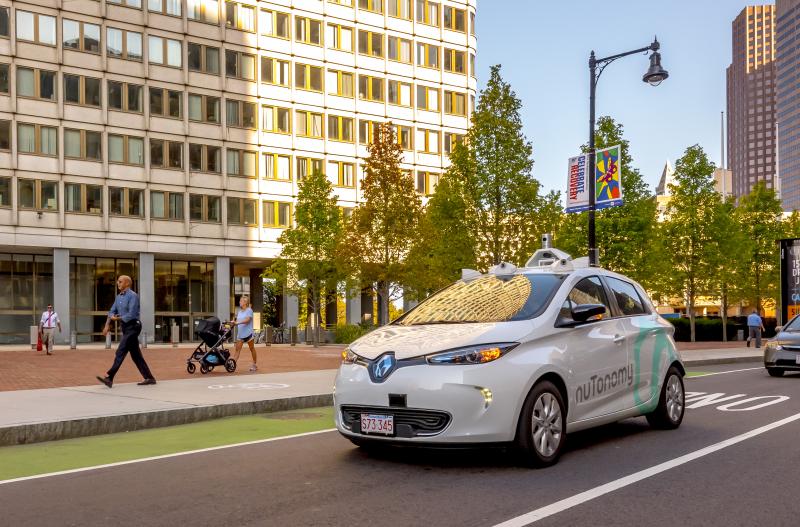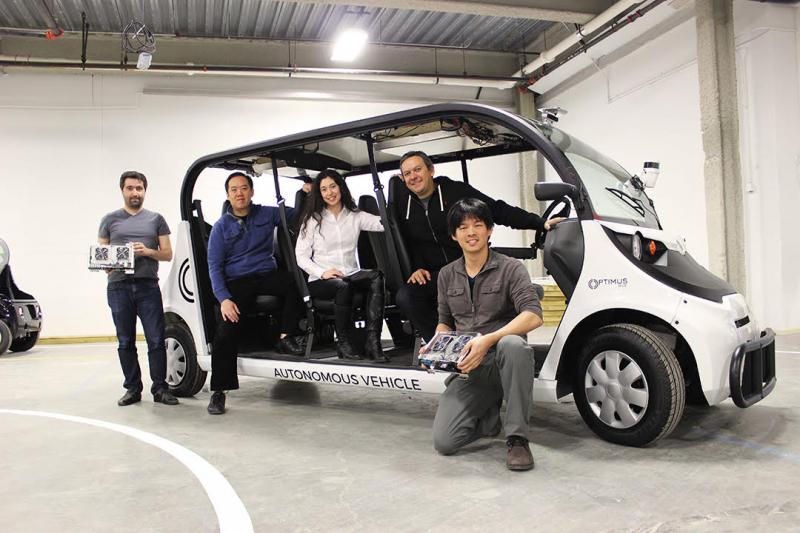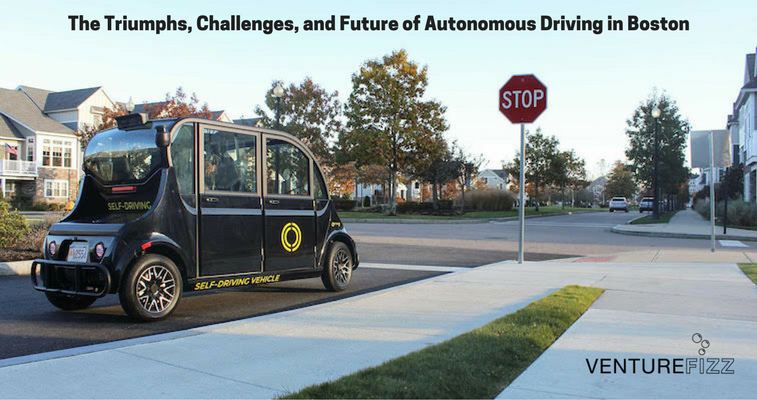To tell the complete story of autonomous driving would be nearly impossible. Where do you even start? Do you start with the “driverless,” radio-controlled American Wonder, developed and tested by Houdina Radio Control in 1925? Do you start with Marvin Minsky, the famed MIT scientist largely credited as the father of artificial intelligence? Or somewhere else altogether?
The story I’m telling starts in 2016, and discusses a small, crucial, ongoing time period in Boston’s intersection with autonomous vehicles. That said, it is by no means the complete story. A number of autonomous driving-centric companies, like nuTonomy and Optimus Ride, were founded well before 2016. Moreover, the research and thought on this subject goes back decades, and there are many more characters in Boston’s story than those listed here.
But I do think that, decades from now, when we think back on the history of autonomous driving in our city, we will point to September 14, 2016 as a critical day in our adoption of this technology. That’s the day when Boston Mayor Martin Walsh announced the city’s autonomous vehicle initiative.
The program, done in partnership with the World Economic Forum and the Boston Consulting Group, began as an effort to explore the potential of autonomous technologies in our city, and would include, “a year-long engagement focused on creating policy recommendations and supporting on-street testing of autonomous vehicles, also known as self-driving vehicles, to advance the safety, access and sustainability goals identified by the public during the Go Boston 2030 transportation planning process.”
Go Boston 2030 is another initiative, originally announced in 2015, that lays out the future of Boston’s transportation. You can see the aforementioned goals right here (as well as the rest of the Vision and Action Plan released last March), but it generally comes down to making the city more safe, reliable, and accessible.
The Benefits of Autonomous Vehicles
From the city’s perspective, there are a number of things to like about autonomous vehicles. By taking human hands out of the equation and replacing them with (theoretically) more reliable technology, there’s potential to significantly decrease fatalities. They can also speed up traffic flow, among other benefits.
“Autonomous vehicles, particularly if they’re shared, can increase reliability and reduce emissions on city streets, and frees up parking for alternative uses whether it’s additional sidewalks, sidewalk cafes, etc,” said Chris Osgood, Mayor Walsh’s Chief of the Streets.
According to this 2015 report by McKinsey & Company, self-driving cars could, by midcentury, reduce crashes by up to 90%, save billions of dollars doing so, and free up 50 minutes a day for drivers.
But why are so many companies coming to Boston as a testing ground for the future? In addition to the history, the schools, and our strong talent pool (the stuff you probably know about already), there are couple of other reasons why automotive technology companies are taking such increased interest in Boston.
“I think there's interest in being on streets like ours, given the complexity of our weather conditions,” said Kris Carter, Co-Chair of the Mayor's Office of New Urban Mechanics (Boston’s civic research and development team). “Solving that complexity allows AVs to be able to be used in a variety of different contexts.”
One cannot overstate the impressive weather variation in our city. There’s that famous Mark Twain quote: “If you don't like the weather in New England now, just wait a few minutes.”
Dr. Ryan Chin, Co-Founder and CEO of Optimus Ride, expressed something similar.
“We have some unique challenges that actually makes the testing and validation of autonomous vehicles even more robust. Our road network in Boston is the inverse of Manhattan in many ways. Our organic, non-gridded streets—combined with complex intersections like rotaries—allow us to push the limits of our driving algorithms.”
Two Executive Orders
On October 20, 2016, Mayor Walsh signed an executive order that established the framework for developing AV testing guidelines. He also appointed Boston Transportation Commissioner Gina Fiandaca to lead oversight on the technology’s presence in the city.
“I’m very excited about the transformative nature of autonomous vehicles as it relates to the transportation and mobility options for our citizens, and how it can really support economic growth for the City of Boston,” Fiandaca said. “It’s great to see Boston be at the forefront of the socialization of this technology.”
The same day, Governor Charlie Baker signed one of his own for the state, with much of the same intent to test and deploy self-driving cars. The order also created the Autonomous Vehicles Working Group, which looks to “encourage the development of autonomous vehicles and their component parts in Massachusetts.” The working group was established to discuss and examine matters like safety concerns and proposed legislation.
From these efforts, three testing partners were approved to test AV tech in 2017: Delphi (now Aptiv), nuTonomy (acquired by Aptiv in October for $450M), and Optimus Ride. nuTonomy and Optimus Ride are two MIT spin-off companies making software for self-driving vehicles, and Aptiv is an automotive supplier currently in the process of developing a turnkey autonomous driving system.
Premier Pilots, Cool Companies, and Fundraising
At the beginning of last year, the first testing was done in the Raymond L. Flynn Marine Park in South Boston (led by nuTonomy), exclusively under good weather conditions. Later in the year, the Seaport District opened up to companies for additional testing. In December, nuTonomy launched its own passenger pilot, and also partnered with Lyft to provide live passenger rides in that area. Lyft is also partnering with Aptiv, who provided over 400 rides with the ridesharing company during CES 2018.

“Lyft’s self-driving network gives the opportunity to take more cars off the road, which will reduce accidents, traffic and carbon emissions,” a Lyft spokesperson said via email. “Fewer cars means fewer parking structures and more room for green spaces. By sharing rides and utilizing these public spaces, people will engage with one another more and connect as a community. This transportation revolution has the power to reshape our communities and we are thrilled to be working towards this future.”
Optimus Ride is preparing to do passenger rides too, though of a slightly different nature. In November, the company announced a partnership with LStar Ventures for an 18-month pilot that the company claims will be the first revenue-generating AV pilot program. Its fleet will be on-site at Union Point, a 1550-acre urban development located in Weymouth, where it will start taking passengers on rides within the site in the next few months.
In addition to those three, there are a number of other companies currently involved with (or at least researching) AV technology. One of them is Perceptive Automata, a Harvard spin-out that claims to be building “the next generation of AI.” While CTO Sam Anthony was being slightly cryptic about what his company was up to, he did suggest it would involve making vehicles more human-like.
“I walk and ride my bike a lot, and pay a lot of attention to the social interactions between different kinds of vehicles in cities. I knew from my research at Harvard that these kinds of interactions were something that humans find effortless, but that computers have historically been pretty hopeless at solving. I thought that if autonomous vehicles got deployed without the ability to navigate these complex interactions, they might work in some sense, but they’d cause lots of problems and build up a terrible reputation very quickly. I realized that our machine learning methods could quickly help solve this problem.”
Agero—known for their telematics solutions, accident management services, and roadside assistance—is a founding member of the Advanced Vehicle Technology (AVT) Consortium, launched in September 2015 to research driver behavior. But while many are solely discussing the exciting future of full-on driverless cars, SVP of Strategy Jeff Blecher looks at the near future with much more intent.
“As a supplier to most auto insurance companies and automotive manufacturers in the U.S., and providing vehicle safety services to them, it’s really important to keep abreast of all of the changes that are happening in the world of autonomy,” Blecher said. “We think that the world of semi-autonomy is going to be much more impactful in the short term than full autonomy, and right now we’re spending most of our efforts leveraging our mobile telematics platform with the MIT Advanced Vehicle Technology Consortium to build an industry-leading understanding of changing risk profiles with the adoption of semi-autonomous technologies.”
And ClearMotion, whose proactive ride system attenuates vehicle movement through a combination of actuators and software (resulting in a smoother overall car ride), sees great potential in their tech being applied in self-driving cars. Though he avoided committing to specifics, Founder and CEO Shakeel Avadhany showed me a whitepaper that discussed how technology like ClearMotion’s could reduce motion sickness in autonomous vehicles.
“When you call an Uber, does it matter to you what Uber you pick, or what brand picks you up—or is it about the experience you have? I think the same can be said of autonomy. Does it matter which pod picks you up, or how much time it takes to be picked up? Or is it about the experience in that cabin, where you can take your time and not feel motion sick—where your coffee can sit on a retractable table and not fall into your lap?”

With all the companies excited to work on autonomous vehicles right now, it should come as no surprise that some companies are raising a lot of money. Optimus Ride has raised a total of $23.25M through a Series A and seed round. And before it was acquired for nearly half a billion dollars, nuTonomy raised $19.6M across its two funding rounds.
I talked to Bob Davis, General Partner at Highland Capital Partners, about nuTonomy’s Series A—an investment he spearheaded. He said that it was their leader, Co-Founder and President Karl Iagnemma, who sealed the deal, calling him an “outstanding leader” with a “magical aura surrounding him.” I also asked him about the process of betting on an autonomous vehicle company, and how that compares to investing in a more established industry.
“It’s not that different. Everything we do is about betting on what isn’t there and hoping it might be. Whether it’s a small company in an industry that might grow, or whether it’s very new and different like nuTonomy, we’re hoping that we can create value out of the dreams and visions of really smart entrepreneurs.”
Regulations
Last January, Bill H.1829, “An Act to promote the safe integration of autonomous vehicles into the transportation system of the Commonwealth,” was presented by Representative Tricia Farley-Bouvier and Senator Jason M. Lewis to establish a formalized set of AV regulations.
“There are so many benefits to autonomous vehicles, but if we don’t have the right policies in place, it could lead to worsening conditions when it comes to our transportation infrastructure,” Representative Farley-Bouvier said. “For example, without the appropriate policy in place, we could actually be increasing traffic by 20-30%. Let’s say you take your autonomous car to work. It would cost you less to just send it back home again when you’re working, rather than for you to pay to park. And then you tell your car to pick you up when it comes time to pick you up. So now your car is taking four trips a day instead of two.”
Because of these congestion concerns, Farley-Bouvier says that it’s necessary to prohibit most empty vehicles from traveling around. She also expressed concern whether these cars would be all-electric, zero-emissions vehicles. This would be ideal, she says (and the bill mandates that all self-driving cars under 8,500 pounds be zero-emissions), except for one little thing: gasoline taxes.
“Our primary source of revenue for transportation infrastructure is the gasoline tax. And we are already seeing diminishing revenues when it comes to the gasoline tax, because more and more people are using more and more efficient vehicles—and we want that. But we have to address this issue of transportation revenue. And this bill calls for a road use tax instead of a gas tax.” That road tax represents a base fee of 2.5 cents for every mile of travel.
The bill has not yet passed, though Farley-Bouvier expects progress soon. It represents an early, formal attempt at balancing the hopes of this blossoming technology with government regulation. That said, the bill has been met with mixed reception.
“This bill allows for and encourages automated vehicles anywhere in the Commonwealth, as opposed to just saying, ‘Here’s a test area you can do it in.’ And so, we think it’s pretty progressive, and it’s encouraging innovation in the commonwealth,” she said. “What we want the industry to know is that we’re a really friendly place to test and develop your vehicles with new technology.”
Today and Tomorrow

As Osgood explained to me, 2017 was all about testing the technology. In 2018, Boston’s Chief of the Streets said that the city is going to take their work even further.
“2018 is going to be an extension of our work in 2017. We’ll be further testing the tech, and we’ll be working more and more with partners and stakeholders in the Boston area. We’ll be further supporting the evolution of autonomous vehicles.”
When it comes to the triumphs in autonomous vehicles, Boston’s got them. We have an engaged local government rooting on cool tech to win, industry innovators like nuTonomy and Optimus Ride, and one of the few opportunities in history for us to draw people into the city with our “dynamic” weather.
The challenges will likely come not just from perfecting the technology, but also the regulation—and the balancing act that comes with it.
As for the future, those I interviewed generally agreed that lower-level autonomous vehicles would likely be more widely available to consumers in the next few years. But full autonomy—the technology that nuTonomy, Optimus Ride, and many others are chasing—seems to be a ways off. Still, the future looks bright.
“If you were to look back a year ago, we were just starting testing on a small couple blocks of a city,” Osgood said. “A year later we were testing with passenger pilots. I expect that by the end of this year, we will see a continuation of that trajectory, with more companies interested in testing, and we’re going to get closer to what a commercialized autonomous vehicle will look like.”
Alexander Culafi is a Staff Writer for VentureFizz. You can follow him on Twitter @culafia.
Images provided by Optimus Ride (including photo used for masthead) and nuTonomy. Chris Osgood photo obtained from Boston.gov.

